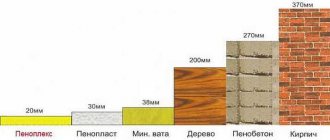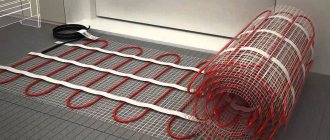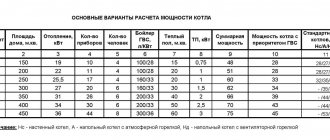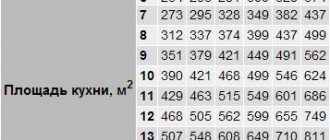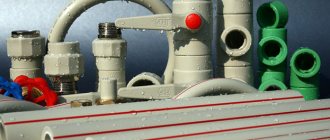What is dew point
Dew point is the temperature at which condensation begins to form.
The term denotes the temperature at which the maximum saturation of air with water vapor occurs. When it cools below the critical point, drops form on objects or fog.
The phenomenon is based on the fact that the maximum steam capacity per cubic meter. m of air changes with its temperature.
Examples (data given in grams):
- -5°C - 3.25.
- 0°C - 4.85.
- +10°C - 9.41.
- +22°С - 19.44.
- +28°С - 27.26.
The relative humidity indicator means what proportion the current specific amount of steam is from the maximum possible. For example, if this parameter is 34.5% at +28°C, the vapor content in the air will be 27.26*0.345=9.4047 g/cubic meter. m. Based on the above list, when cooled to +10°C, the relative humidity will reach approximately 100%, i.e. a given temperature under such conditions is the dew point. If the air cools even more, the amount of steam will become excessive, and some of it will fall into condensation.
Scope of application of the concept
The transition of moisture into a liquid state of aggregation significantly changes the living and working conditions of people and affects the operation of structures and mechanisms. Therefore, in many areas, special attention is paid to the point of steam precipitation.
Construction
The enclosing structures of most buildings are vapor permeable. The only exceptions are metal hangars and garages. The relative humidity inside the room is higher than outside, and steam penetrates the walls under the influence of partial pressure.
Buildings have vapor permeability, which depends on the type of building material.
If there are areas in their thickness with a saturation temperature or lower, it condenses, which leads to the following consequences:
- Reducing the thermal resistance of the structure.
- Reducing the service life of building materials. When it gets colder, water turns to ice and expands, causing internal damage.
- Development of mold and mildew colonies (when the surface is moistened).
Building materials have different vapor permeability. The lowest indicator for heavy reinforced concrete (panel houses) is 0.03 mg/m*h*Pa, the highest for aerated concrete blocks is 0.23 (at a density of 400 kg/cubic m).
Agriculture
When the air temperature drops, moisture condenses on the shoots and leaves of plants. If repeated frequently, it provokes disease. Thus, knowledge of the condensation point of water vapor allows you to plan preventive and therapeutic measures.
Moisture condenses on the leaves of plants.
In arid regions, on the contrary, condensation of atmospheric moisture can partially replace the irrigation system. Breeders are working to develop varieties that can absorb water in this way. Then knowing the critical point will help determine the required performance of irrigation systems if the weather forecast does not predict rain in the near future.
Measures to protect some plants, such as grapes, are also planned taking this parameter into account. If it is high, it means that the air contains a lot of moisture, and damage from frost, incl. radiation will be moderate.
If the location of the steam condensation zone is low, the shoots are wrapped or the area is watered.
When is internal insulation possible?
Table for determining dew point depending on air temperature and humidity.
It is not always possible to carry out insulation from the inside, since if done incorrectly, dew will constantly fall out from the inside, rendering all building materials completely unusable, creating an uncomfortable microclimate inside. Let's consider when it is not recommended to insulate from the inside, and what it depends on.
Is it possible or not to insulate from the inside? The solution to this issue largely depends on what will happen to the structure after the work is completed. If the wall remains dry all year round, then work on its thermal insulation from the inside of the room can be carried out, and in many cases it is even necessary. But if it constantly gets wet every winter, then it is absolutely impossible to carry out thermal insulation. Insulation is allowed only if the structure is dry and it gets wet extremely rarely, for example, once every ten years. But even in this case, work must be carried out very carefully, since otherwise such a phenomenon as the dew point will be observed constantly.
Let's consider what determines the occurrence of the dew point, how to find out whether or not it is possible to insulate the walls of a house from the inside.
As already said, the dew point arises due to factors such as:
- humidity;
- indoor temperature.
Related article: Budget ideas for country interior (35 photos)
The humidity in the room depends on the presence of ventilation (hood, supply ventilation, air conditioners, etc.) and on the mode of residence, temporary or permanent. The temperature inside is affected by how well the insulation was installed and the level of thermal insulation of all other structures of the house, including windows, doors, and roof.
From this we can conclude that the consequences for internal insulation depend on:
- temperature of condensation moisture, that is, from the dew point;
- from the position of this point to the thermal insulation and after it.
How to determine where the dew point is? This value depends on many parameters, among which it is necessary to highlight:
- thickness, wall material;
- average indoor temperature;
- average outside temperature (influenced by climate zone, average weather conditions throughout the year);
- indoor humidity;
- the level of humidity outside, which depends not only on the climate, but also on the operating conditions of the house.
Let's put all the factors together
Graph of thermal resistance and dew point shift when using insulation.
Now we can collect all the factors that influence where the dew point will be located:
- mode of residence and operation of the house;
- availability of ventilation and its type;
- quality of the heating system;
- quality of work when insulating with foam plastic or other material all structures of the house, including the roof, doors, windows;
- thickness of individual layers of the wall;
- temperature indoors, outdoors;
- humidity indoors, outdoors;
- climate zone;
- operating mode, i.e. what is outside: street, garden, other room, attached garage, greenhouse.
Insulation from the inside is possible, based on all the above factors, in the following cases:
- when permanently residing in the house;
- when installing ventilation in accordance with all standards for a particular room;
- during normal operation of the heating system;
- with insulation, which is laid for all structures of the house that require thermal insulation;
- if the wall is dry, it has the required thickness. According to the standards, when insulating with polystyrene foam, mineral wool and other materials, the thickness of such a layer should not be more than 50 mm.
Related article: How to insulate and finish a basement
In other cases, insulation cannot be performed from the inside. As practice shows, in 90% of cases the walls of a house can only be thermally insulated from the outside, since it is quite difficult to provide all the conditions, and often not entirely feasible.
Dew point calculation
There are several ways to define a parameter.
According to the mathematical formula
The following expression applies:
Tp=b((aT/b+T)+InRH)/a-((aT/b+T)+InRH), where
Tr—dew point, °C;
The dew point is calculated using mathematical formulas.
A and b are dimensionless coefficients equal to 17.27 and 237.7, respectively;
RH—relative air humidity in fractions of a unit;
T—air temperature, °C;
Ln is the natural logarithm.
The given formula is valid for values T=0...+60°С and atmospheric pressure 762 mm. rt. Art.
Calculator programs
Specialized applications perform calculations automatically. The user needs to enter the initial data and click the “Start” button. In addition to the numerical result, the programs display graphs of the dependence of humidity on the degree of air heating. This form of presenting information is more visual.
Using an online calculator
Computing services are available on many websites. They relieve the user of the need to purchase and download the program.
There are online calculators on many websites.
Enter data into special fields:
- air temperature;
- relative humidity;
- Atmosphere pressure.
After pressing the “Calculate” button, the desired value is displayed on the screen.
The disadvantage of this method is that the manufacturer of the calculator is in most cases unknown, so the result may be unreliable.
Unlike online services, popular programs from well-established developers are 100% reliable.
Special tools
There are thermal imagers with a dew point calculation function. Objects with this or lower temperature are marked on the screen in a special way.
A hygrometer is a measuring device designed to determine air humidity.
Humidity is measured using instruments:
- Hygrometer. The electronic device is convenient to use, but it produces calculations with a large error.
- Psychrometer. It consists of 2 alcohol thermometers. The flask of one is wrapped with a damp cloth. Due to the evaporation of water, the readings on it will be lower than on the “dry” one. The lower the humidity in the room, the more actively the liquid evaporates. This means that the difference in readings will be greater. The result is found in the directory manually. The desired point determined using a psychrometer is the most accurate.
Tables
Tables with dew point values for air with different parameters are published on the Internet and in specialized literature.
Example:
| Air temperature, °C | Saturation temperature in °C at air humidity (in%) | |||||||||||||
| 30% | 35% | 40% | 45% | 50% | 55% | 60% | 65% | 70% | 75% | 80% | 85% | 90% | 95% | |
| -10 | -23,2 | -21,8 | -20,4 | -19 | -17,8 | -16,7 | -15,8 | -14,9 | -14,1 | -13,3 | -12,6 | -11,9 | -10,6 | -10 |
| -5 | -18,9 | -17,2 | -15,8 | -14,5 | -13,3 | -11,9 | -10,9 | -10,2 | -9,3 | -8,8 | -8,1 | -7,7 | -6,5 | -5,8 |
| 0 | -14,5 | -12,8 | -11,3 | -9,9 | -8,7 | -7,5 | -6,2 | -5,3 | -4,4 | -3,5 | -2,8 | -2 | -1,3 | -0,7 |
| +2 | -12,8 | -11 | -9,5 | -8,1 | -6,8 | -5,8 | -4,7 | -3,6 | -2,6 | -1,7 | -1 | -0,2 | -0,6 | 1,3 |
| +4 | -11,3 | -9,5 | -7,9 | -6,5 | -4,9 | -4 | -3 | -1,9 | -1 | 0 | 0,8 | 1,6 | 2,4 | 3,2 |
| +5 | -10,5 | -8,7 | -7,3 | -5,7 | -4,3 | -3,3 | -2,2 | -1,1 | -0,1 | 0,7 | 1,6 | 2,5 | 3,3 | 4,1 |
| +6 | -9,5 | -7,7 | -6 | -4,5 | -3,3 | -2,3 | -1,1 | -0,1 | 0,8 | 1,8 | 2,7 | 3,6 | 4,5 | 5,3 |
| +7 | -9 | -7,2 | -5,5 | -4 | -2,8 | -1,5 | -0,5 | 0,7 | 1,6 | 2,5 | 3,4 | 4,3 | 5,2 | 6,1 |
| +8 | -8,2 | -6,3 | -4,7 | -3,3 | -2,1 | -0,9 | 0,3 | 1,3 | 2,3 | 3,4 | 4,5 | 5,4 | 6,2 | 7,1 |
| +9 | -7,5 | -5,5 | -3,9 | -2,5 | -1,2 | 0 | 1,2 | 2,4 | 3,4 | 4,5 | 5,5 | 6,4 | 7,3 | 8,2 |
| +10 | -6,7 | -5,2 | -3,2 | -1,7 | -0,3 | 0,8 | 2,2 | 3,2 | 4,4 | 5,5 | 6,4 | 7,3 | 8,2 | 9,1 |
| +11 | -6 | -4 | -2,4 | -0,9 | 0,5 | 1,8 | 3 | 4,2 | 5,3 | 6,3 | 7,4 | 8,3 | 9,2 | 10,1 |
| +12 | -4,9 | -3,3 | -1,6 | -0,1 | 1,6 | 2,8 | 4,1 | 5,2 | 6,3 | 7,5 | 8,6 | 9,5 | 10,4 | 11,7 |
| +13 | -4,3 | -2,5 | -0,7 | 0,7 | 2,2 | 3,6 | 5,2 | 6,4 | 7,5 | 8,4 | 9,5 | 10,5 | 11,5 | 12,3 |
| +14 | -3,7 | -1,7 | 0 | 1,5 | 3 | 4,5 | 5,8 | 7 | 8,2 | 9,3 | 10,3 | 11,2 | 12,1 | 13,1 |
| +15 | -2,9 | -1 | 0,8 | 2,4 | 4 | 5,5 | 6,7 | 8 | 9,2 | 10,2 | 11,2 | 12,2 | 13,1 | 14,1 |
| +16 | -2,1 | -0,1 | 1,5 | 3,2 | 5 | 6,3 | 7,6 | 9 | 10,2 | 11,3 | 12,2 | 13,2 | 14,2 | 15,1 |
| +17 | -1,3 | 0,6 | 2,5 | 4,3 | 5,9 | 7,2 | 8,8 | 10 | 11,2 | 12,2 | 13,5 | 14,3 | 15,2 | 16,6 |
| +18 | -0,5 | 1,5 | 3,2 | 5,3 | 6,8 | 8,2 | 9,6 | 11 | 12,2 | 13,2 | 14,2 | 15,3 | 16,2 | 17,1 |
| +19 | 0,3 | 2,2 | 4,2 | 6 | 7,7 | 9,2 | 10,5 | 11,7 | 13 | 14,2 | 15,2 | 16,3 | 17,2 | 18,1 |
| +20 | 1 | 3,1 | 5,2 | 7 | 8,7 | 10,2 | 11,5 | 12,8 | 14 | 15,2 | 16,2 | 17,2 | 18,1 | 19,1 |
| +21 | 1,8 | 4 | 6 | 7,9 | 9,5 | 11,1 | 12,4 | 13,5 | 15 | 16,2 | 17,2 | 18,1 | 19,1 | 20 |
| +22 | 2,5 | 5 | 6,9 | 8,8 | 10,5 | 11,9 | 13,5 | 14,8 | 16 | 17 | 18 | 19 | 20 | 21 |
| +23 | 3,5 | 5,7 | 7,8 | 9,8 | 11,5 | 12,9 | 14,3 | 15,7 | 16,9 | 18,1 | 19,1 | 20 | 21 | 22 |
| +24 | 4,3 | 6,7 | 8,8 | 10,8 | 12,3 | 13,8 | 15,3 | 16,5 | 17,8 | 19 | 20,1 | 21,1 | 22 | 23 |
| +25 | 5,2 | 7,5 | 9,7 | 11,5 | 13,1 | 14,7 | 16,2 | 17,5 | 18,8 | 20 | 21,1 | 22,1 | 23 | 24 |
| +26 | 6 | 8,5 | 10,6 | 12,4 | 14,2 | 15,8 | 17,2 | 18,5 | 19,8 | 21 | 22,2 | 23,1 | 24,1 | 25,1 |
| +27 | 6,9 | 9,5 | 11,4 | 13,3 | 15,2 | 16,5 | 18,1 | 19,5 | 20,7 | 21,9 | 23,1 | 24,1 | 25 | 26,1 |
| +28 | 7,7 | 10,2 | 12,2 | 14,2 | 16 | 17,5 | 19 | 20,5 | 21,7 | 22,8 | 24 | 25,1 | 26,1 | 27 |
| +29 | 8,7 | 11,1 | 13,1 | 15,1 | 16,8 | 18,5 | 19,9 | 21,3 | 22,5 | 22,8 | 25 | 26 | 27 | 28 |
| +30 | 9,5 | 11,8 | 13,9 | 16 | 17,7 | 19,7 | 21,3 | 22,5 | 23,8 | 25 | 26,1 | 27,1 | 28,1 | 29 |
| +32 | 11,2 | 13,8 | 16 | 17,9 | 19,7 | 21,4 | 22,8 | 24,3 | 25,6 | 26,7 | 28 | 29,2 | 30,2 | 31,1 |
| +34 | 12,5 | 15,2 | 17,2 | 19,2 | 21,4 | 22,8 | 24,2 | 25,7 | 27 | 28,3 | 29,4 | 31,1 | 31,9 | 33 |
| +36 | 14,6 | 17,1 | 19,4 | 21,5 | 23,2 | 25 | 26,3 | 28 | 29,3 | 30,7 | 31,8 | 32,8 | 34 | 35,1 |
| +38 | 16,3 | 18,8 | 21,3 | 23,4 | 25,1 | 26,7 | 28,3 | 29,9 | 31,2 | 32,3 | 33,5 | 34,6 | 35,7 | 36,9 |
| +40 | 17,9 | 20,6 | 22,6 | 25 | 26,9 | 28,7 | 30,3 | 31,7 | 33 | 34,3 | 35,6 | 36,8 | 38 | 39 |
Dew point calculation
According to the formula
The simplest calculation is considered to be based on a certain formula.
The indicators in the formula have the following meanings:
- a – constant value – 17.27;
- c – same constancy – 237.7;
- T – temperature degree;
- Rh – relative air humidity at the calculated moment.
Calculating the dew point using this formula is considered quite accurate. The result is obtained with an error of about 0.5.
Sometimes the formula cannot be applied: there is not enough time for calculations or there is no necessary mathematical knowledge and skills. You can use special online calculators on the Internet; they are publicly available. They are easy to use, but for correct calculation you need to know certain initial data.
There are computer programs for determining dew point with additional calculation capabilities. In addition to the main ones, they take into account other indicators:
- geographical location of the proposed construction site;
- purpose of the room: somewhere in the shower, the air humidity will always be much higher than in the room where people live, the choice, for example, of insulation depends on this;
- design features - separate calculations are carried out for walls, ceilings, attics, etc.;
- high-quality construction composition.
Taking into account the indicators, a graph of changes in the dew point over a certain time will be drawn up.
According to the table
It is even easier to determine the dew point using a special table (see attached file).
It is enough to find the intersection point of two main indicators on it, and the dew point will be determined. However, specialists rarely use it: these calculations are very approximate, they do not take into account indirect indicators, and they can greatly influence the final result.
Using devices and tools
Meteorologists regularly determine some natural indicators. For example, air temperature is measured with a high-precision thermometer, and air humidity with a hygrometer. In order to correctly determine the desired point based on these indicators, they usually use a device that can perform both of these functions at once - a thermohygrometer. Use it step by step like this:
- The device turns on and determines the battery charge;
- brought at an angle of 90 degrees to the study site;
- the received data is recorded and saved.
Now all that remains is to connect the thermohygrometer to any computer device and analyze the data. Connecting is no more difficult than manipulating a cell phone.
Location
In addition to the dew point value, the building engineer needs to calculate its position inside the building envelope. This determines where and in what quantity the liquid will appear.
The following factors are taken into account:
- Indoor and outdoor temperatures.
- Humidity inside and outside the house.
- Thermal conductivity of building envelope materials.
- Vapor permeability of walls.
- Their thickness.
The engineer needs to calculate the position of the dew point.
When designing, they try to move the point of condensation formation away from the inner surface of the enclosing structure.
The best option is in which it is located outside the capital elements of the structure.
Options for location of problem areas
The dew point tends to shift, but most often there are three zones of its location:
- Closer to the outer surface of the wall. This option occurs if the wall is not insulated . The appearance of a problem area is also possible if the external insulation is of insufficient thickness.
- Closer to the inner surface of the wall. In the absence of insulation, condensation easily forms in this place during cold weather. Internal insulation shifts the area of condensation formation to the area between the wall surface and the insulation . With external insulation, this phenomenon rarely occurs if all calculations were performed correctly.
- In the thickness of the insulation. For external thermal insulation this is the best option. With internal insulation, there is a high risk of mold appearing in the room and, as a result, microclimate disturbance .
Note! The formation of condensation in the wall is affected not only by the temperature and humidity conditions from the street and the room. Determining factors are also the thickness of the structure and the thermal conductivity of the materials used.
Variations in dew point behavior
The position of the plane with the saturation temperature depends on the presence and method of application of the insulation. Several cases need to be considered.
In uninsulated walls
In this option, the critical point is always located inside the structure.
The position depends on its thickness and the difference between external and internal temperatures:
- Closer to the outer surface. In this case, the wall on the side of the room is always dry. But the outer layer can gradually collapse due to freezing of water. This depends on how much of it reaches the area with the temperature at which steam turns into dew.
- Closer to the inner surface. During extreme cold weather, the inside wall becomes wet.
- On the surface from the room side. The inner surface of the structure does not dry out all winter. Mold colonies develop on a wet wall, poisoning the air with their spores.
In uninsulated walls, the dew point is located inside the structure.
The above does not apply to a frame house, the walls of which consist of insulation and vapor-tight cladding.
In externally insulated walls
In this option, the critical point shifts towards the street.
It can be located:
- Insulated. This is the best option. Moisture in the wall does not condense, so the structure lasts for the entire prescribed period. The condition for moving the steam condensation point beyond the base material is a large thickness of the heat insulator.
- In the wall. This situation occurs when the insulation thickness is insufficient. The moisture formation zone can occupy any position (up to the inner surface).
The insulation must exceed the base material of the wall in terms of vapor permeability. Otherwise, moisture will accumulate at the border between them. Thus, it is impossible to insulate walls made of brick (0.17) and aerated concrete (0.11-0.23) with foam plastic, the vapor permeability coefficient of which is 0.05 mg/m*h*Pa.
In walls insulated from the outside, the critical point shifts towards the street.
In internally insulated walls
The critical point shifts towards the room. Possible options:
- In the wall closer to the inner surface. Most of the time the structure remains dry, but in extreme cold it gets wet.
- On the inner surface of the base material. The moisture does not dry out all winter.
- Insulated. The structure remains wet all winter. In extreme cold weather, the insulation also gets wet.
Internal insulation is used only as a last resort. For example, if the outer side of the wall opens into an elevator shaft. In other situations, the heat insulator is placed externally, otherwise the service life of the structure is greatly reduced.
In walls insulated from the inside, the point shifts towards the room.
In plastic windows
Metal-plastic windows are vapor-tight products.
Therefore, there are only 2 options for surface temperature on the room side:
- Above a critical value.
- Below this parameter.
In the second case, the windows “sweat.”
The term "dew point" in construction
The constantly growing and developing market for construction products presents a wide selection of materials for thermal insulation. The choice of thermal insulation for industrial and residential premises must be approached properly and during construction, pay attention to the indicator in question.
Due to incorrect measurement of the dew point, fogging of walls often occurs, mold appears, and sometimes destruction of structures
Experts consider the boundary of transition from low temperatures outside the walls to higher temperatures inside heated structures with the possible formation of condensation to be the dew point. Drops of water will appear on any surface in the room whose temperature is close to the dew point parameter or reaches a value lower. The simplest example: in the middle of some rooms, condensation flows onto the window panes during cold times.
The main factors influencing the determination of the value are:
- climatic factors (temperature and air humidity outside);
- temperature values inside;
- indoor humidity indicator;
- wall thickness;
- vapor permeability of thermal insulation used in construction;
- availability of heating and ventilation systems;
- purpose of structures.
Correct determination of dew point is of utmost importance in construction
Only if the indicator is measured correctly can the building be used comfortably in the future and will reduce maintenance costs in the future.
How to move the dew point in a wall
The problem can be solved in 3 ways:
- Drying the air in the house.
- Heating of the room.
- Insulation of the building.
You can move the dew point in the wall by heating the room.
To dry the air, do the following:
- Install blowers in ventilation ducts to increase its performance.
- Use a dehumidifier.
When relative humidity is below 40%, people feel uncomfortable. The skin and mucous membranes in the respiratory tract dry out, making it difficult to breathe. Wooden objects crack under such conditions.
An increase in room temperature requires an increase in heating costs, so this method is not economically viable.
It is more expedient to insulate the building.
Consequences of improper thermal insulation
Cases of improper home insulation are rare. Most often this happens when it is impossible to install thermal insulation from the inside, but you did it. In this case, even with the best insulation, various problems will quickly begin to arise, but at first these are wet walls. As a result, the decorative finish loses its attractive appearance. After this, the insulation gradually becomes wet.
It all depends on what kind of material was used during the work: foam plastic does not get wet, while many other materials simply will not have time to dry, after which traces of mold and mildew begin to appear on the surface, which are no longer possible to get rid of. Therefore, it is much easier to immediately foresee how and under what conditions it is possible to carry out work on insulating a house with foam plastic or other material than to spend money and time on eliminating the consequences of incorrect work.
The dew point is the temperature level at which condensation occurs. The appearance of moisture during foam insulation depends on many factors, including the internal temperature in the room and the humidity level. Quite often, constant high humidity, and therefore traces of mold on the surface, occurs due to improperly carried out work on insulating the house, so you should not only understand what the dew point is, but also under what circumstances it occurs, how to avoid this negative phenomenon .
What conditions must be taken into account
The method of shifting the zone of steam precipitation into sediment is chosen depending on the microclimate in the home.
The following signs indicate the need to dry the air:
- Feeling of dampness in the house.
- Wet clothes.
- The appearance of mold stains on the walls and ceiling.
- Frequent respiratory diseases among residents.
The appearance of mold spots indicates the need to dry the air.
In the absence of such phenomena, the building should be insulated.
Air humidity in the insulation
In Russian winter conditions, external walls of premises cannot be built without insulation. Moreover, not only for reasons of heat conservation. If the air temperature inside the room is high and outside on the street is low, then a dew point will inevitably form at the point of contact of these air masses with the formation of humidity. When such a meeting occurs inside a wall, condensation begins to destroy and deform this wall. And if the dew point is close to the interior, wet drops may appear on the wall already in the room.
The ideal option is to have insulation on the outside of the wall. Moreover, the composition of the insulation and its thickness must be selected so that the dew point does not reach directly to the wall.
True, it cannot be constant, this also needs to be taken into account.
Its position depends on several indicators:
- features and quality of wall insulation;
- temperature indicators in the atmosphere and directly in the house;
- the ratio of moisture indoors and outdoors.
These data inevitably change depending on weather conditions, the quality of room heating, and even on the frequency of people being in the house.
Possible consequences
The presence of conditions for moisture condensation in the thickness of the wall may not affect its durability in any way. It all depends on the amount of penetrating moisture. For example, steam enters the outer layers of a thick concrete wall in minute volumes and therefore is not capable of causing noticeable damage.
In an aerated concrete structure, on the contrary, its amount exceeds the permissible minimum, so special attention should be paid to moving the steam condensation zone outside the masonry.
Thus, in each case an individual calculation is required.
Some facts
The issue of the position of the critical point in the wall is removed if you cover it from the inside with a vapor barrier material. Some types of finishes, such as vinyl wallpaper, have these properties. No steam enters the structure, and it will be dry regardless of the temperature distribution. The exception is the case when the wall freezes through and the critical point is on the inner surface.
Covering enclosing elements with vapor barriers is practiced in Western European countries. But this solution has a drawback: to remove excess moisture, you have to increase the air exchange rate, i.e. ventilation performance. This entails an increase in heat loss and, as a consequence, heating costs. A house with “breathing”, i.e. vapor-permeable walls are cheaper.
https://youtube.com/watch?v=LE1lFVb4XjE
Useful tips
To ensure that the relative humidity in the home does not exceed normal values (40%-60%), ventilation should be ensured. This requires an air flow from outside. In houses and apartments with natural ventilation, according to the design, it should enter through the cracks in the windows.
But as a result of their replacement with sealed metal-plastic products, there is no air flow. Ventilation does not work, even if the exhaust ducts are equipped with fans. The problem is solved by installing window or wall valves.
You should also ensure that there is a gap under the interior doors.






